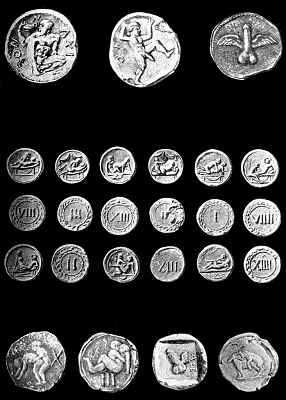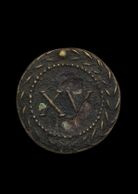سپينتريا

A spintria (plural, spintriae) is a small bronze or brass Roman token. The tokens usually depict on the obverse an image of sexual acts or symbols and a numeral in the range I - XVI on the reverse.
One idea is that it was possibly used in brothels, although none of the literature on the spintriae contains any evidence to support this assertion. Another idea is that they were used as locker tokens in suburban baths.[1]
They were all produced at a single office around 22 to 37 CE.[1]
الاسم
Spintria was used by Suetonius to refer to young male prostitutes,[2] from Greek σφιγκτήρ (sphinktḗr, [anal] sphincter). In the 16th century, the name passed from the ancient sense of the persons committing outrageous acts – in other words, sexual and/or sensual acts outside what was considered the norm – (or the place where outrageous acts occurred, such as Tiberius' gardens on the isle of Capri) to the tokens themselves.[3]
Bette Talvacchia identifies the first usage of the term spintriae to refer to the tokens as occurring in Sebastiano Errizo's 1559 treatise, Discourse Concerning Ancient Medals (Sopra le Medaglie Antiche, Venice, 1559).[4]

الاستخدام
Some scholars, following Friedlander's (1886) suggestion that the tokens were used to obtain entry to brothels ("auf die man in Bordelle Einlass erhielt"), have argued that spintriae were used to pay prostitutes, although none offer any supporting evidence. Buttrey is dismissive of the brothel token idea, asserting "there is no evidence for any of this" (Buttrey 1973, p. 53). Currently, only Simonetta and Riva are supporters of the brothel token hypothesis,[5] which is also popular with the media (see Duggan 2016); other scholars pursue alternate lines of enquiry (Buttrey; Campana; Duggan; Fishburn; etc.). Under Caracalla, an equestrian was sentenced to death for bringing a coin with the emperor's likeness into a brothel; he was spared only by the emperor's own death.[6] There is no direct ancient evidence, however, to support the theory that spintriae were created as tokens for exchange in place of official coinage. Numismatist Theodore V. Buttrey suggests that they were used as game pieces.[7] although Duggan (2016) notes there are no archaeological finds to confirm the spintriae were gaming pieces. [3]
It has been suggested that the most plausible explanation seems to be that they were used as locker tokens in suburban baths.[1][3] On the walls of the suburban baths in Pompeii there are frescos that have been painted with sexual scenes that are the same as the ones on the coins.[1] On these sexual scenes painted on the frescos there were also "...accompanying numerals, as appear on the reverses"[1][3] of the coins. When the spintria was given as a token it gave a person access to a locker where clothes could be stored while bathing.[1][3][8]
Spintriae also do not have wearing that is evident on coins that have been in mass circulation and there are also relatively few compared with the amount of official coins that exist.[1] The spintriae were also all produced at a single office around 22-37 CE,[1] a short period of time.
Another idea is that they were possibly an attempt at increasing revenue.[1] This attempt may have been related to the prohibition of carrying coins into brothels that had an image of the emperor on them. [1] After a short amount of time they may have been able to see that if it were to continue it could have adverse effects for brothels or bring them to a standstill and they ceased being used.[1]
المظهر
They were usually struck from brass or bronze, and were little smaller than a 50 euro cent coin (€0.50).
They show images of sexual scenes involving male and female figures[3] and five spintriae have been given the description of "Male lovers on bed".[9][3]
معرض
Spintriae, showing an erotic scene on one side. On the reverse is a number. Hunterian Museum and Art Gallery, Glasgow
انظر أيضاً

الهامش
- ^ أ ب ت ث ج ح خ د ذ ر ز (11 July 2007) "Is that a Spintria in your Pocket, or Are You Just Pleased to See Me?" in 20th Conference of the History of Economic Thought Society of Australia.: 225–236, Brisbane: University of Queensland Printery.
- ^ Fishburn, page 10, note 2.
- ^ أ ب ت ث ج ح خ Duggan, Eddie (October 2017). "Stranger Games: The life and times of the spintriae". Board Game Studies Journal. 11 (1): 101–121. doi:10.1515/bgs-2017-0005. S2CID 67801461. Archived from the original on 18 April 2022. Retrieved 18 April 2022.
- ^ Talvacchia, 1999, p. 56.
- ^ Simonetta, B. and Riva, R., 1981, Le Tessere erotiche romane (spintriae): Quando ed a che scopo sono state coniate Gaggini-Bizzozero. Lugano)
- ^ Cassius Dio 78.16.5.
- ^ Thomas A. McGinn, The Economy of Prostitution in the Roman World (University of Michigan Press, 2004), p. 115
- ^ Darya (24 May 2021). ""Anal Tokens": The Story of the Roman Spintriae Coins". Shunga Gallery. Archived from the original on 28 May 2021. Retrieved 17 April 2022.</}}
- ^ Multiple sources:
- {{|url=https://www.britishmuseum.org/collection/object/C_R-4473 |website=British Museum |title=spintria |work=British Museum |access-date=18 April 2022}}
- {{|url=https://www.britishmuseum.org/collection/object/C_R-4474 |website=British Museum |title=spintria |work=British Museum |access-date=18 April 2022}}
- {{|url=https://www.britishmuseum.org/collection/object/C_R-4476 |website=British Museum |title=spintria |work=British Museum |access-date=18 April 2022]}
- {{|url=https://www.britishmuseum.org/collection/object/C_R-4481 |website=British Museum |title=spintria |work=British Museum |access-date=18 April 2022}}
- {{|url=https://www.britishmuseum.org/collection/object/C_R-4483 |website=British Museum |title=spintria |work=British Museum |access-date=18 April 2022}}
- ^ Archaeo - Histories (2023-09-30). "spintria". Twitter.
المراجع
- Buttrey, T. V. (1973) 'The Spintriae as a Historical Source', The Numismatic Chronicle 13, pp. 52 – 63.
- Campana, A. (2009) 'Le spintriae: tessere Romane con raffigurazione erotiche', La Donna Romana: Immagini E Vita Quotidiana Atti de Convegno. Astina, 7 Marzo 2009. pp. 43 – 96.
- Duggan, E. (2016) "Stranger Games: The Life and Times of the Spintriae".
- Jacobelli, L. (1995) Le pitture erotiche delle Terme Suburban di Pompeii. L'Erma di Bretschneider. Rome.
- Lee, Bartholomew (Fall 1983). ""Brass Checks" Return: An Excursus in Erotic Numismatics, or The Spintriae Roll Again". The Journal of Popular Culture. 17 (2): 142–145. doi:10.1111/j.0022-3840.1983.1702_142.x.
- Martínez Chico, D. (2018). "Sexo y erotismo en las llamadas spintriae, las supuestas y problemáticas tesserae de lupanar de la Antigua Roma". Athenaeum. Studi di Letteratura e Storia dell'Antichità. 106 (2): 533–557. "PDF" (in Spanish).
{{cite news}}: CS1 maint: unrecognized language (link) - Talvacchia, Bette, 1999, Taking Positions: On the Erotic in Renaissance Culture, Princeton NJ: Princeton University Press.
- Talvacchia, Bette, 1997, 'Classical Paradigms and Renaissance Antequarianism in Giulio Romano's "I Modi"', I Tatti Studies in the Italian Renaissance 7 (1999) pp. 81–188.
وصلات خارجية
المصادر الرئيسية
- "Is that a spintria in your pocket, or are you just pleased to see me?", Geoffrey Fishburn, University of Queensland, Australia
- Straight Dope on spintria Archived 2008-04-30 at the Wayback Machine
- The Collaborative Numismatics Project -- dated
- Duggan, Eddie (2017). "Stranger Games: The life and times of the spintriae". Board Game Studies. 11: 101–121. doi:10.1515/bgs-2017-0005.




